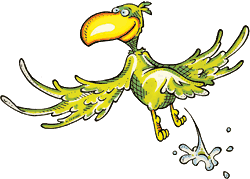October 2, 2010–April 24, 2011
Ever wonder why dogs sniff each other’s rear ends, why cows need four stomachs to digest their food or why cats spit up hair balls? Here’s your chance to find out! Animal Grossology takes a unique and scientific look at nature’s slime-making, vomit-munching and dookie-loving creatures.
Adapted from the best-selling Grossology children’s book series by author and science teacher Sylvia Branzei, this exhibit is oozing with disgusting science and entertaining hands-on learning games such as Blood Sucker Blow-Up, where visitors see what happens when ticks and mosquitoes have too much to drink, and Chew Chew Express, a detailed look at the various steps of digestion in cows, one of the gassiest animals on Earth. Visitors will also learn how leeches are sometimes used after surgeries to assist in the healing process and why scientists are studying the slime produced by slugs and snails for clues in treating cystic fibrosis. Safety tips are dispersed throughout the exhibit, such as what to do if a jellyfish stings you and how to protect your food at the next family picnic. By the way, do you know what honey really is? How do you feel about bee barf on your biscuit?
The exhibit features five thematic areas:
- Blood Slurpers – Blood is very nutritious (high in protein) and many animals slurp blood for their meals. Sometimes, blood slurpers transmit infectious diseases. This exhibit will help identify those that can be a health hazard while providing information that may keep you safe from Lyme Disease, West Nile Virus and Rocky Mountain Spotted Fever.
- Dookie Lovers – Dookie comes in all shapes, sizes and textures, providing scientists with useful answers to many animal mysteries. Here, you will learn how some animals depend on poo for survival, and how others, such as the Scarab Beetle, prevent the spread of disease produced from rotting piles of dung.
- Slime Makers – Slime is essential to some animals, serving important functions such as facilitating motion, aiding in digestion and acting as a defense mechanism. This section explores a plethora of strange underwater creatures and their unique characteristics and encourages you to vote for the “King of Slime.”
- Vomit Munchers – What has four stomachs, four legs and produces 200 liters of saliva daily? Ruminants, which also produce methane gas, making them belch and toot a lot. Some animals have to barf to eat, while others have to spew after they eat. Discover how regurgitation is crucial for some animals’ survival.
- Other Gross Stuff – Discover some not-so-familiar animals, including one that lives in an intestine. Explore how animals use common scents for recognition, attraction and defense.
Educator Guides
- Animal Scat
- Blood Colors
- Candy Animal Poo
- Creepy Crawly Collection
- Fish Printing Workshop
- Can You Jump as High as a Flea?
- Match Up Your New Animal Grossology Terms...
- A Meal of Mealworms
- Observing Worms
- One-Meter Hike
- Owl Pellets
- Which Sea Creature Am I?
- Snail Trails
- Squid Dissection Workshop
Animal Grossology was sponsored by:



